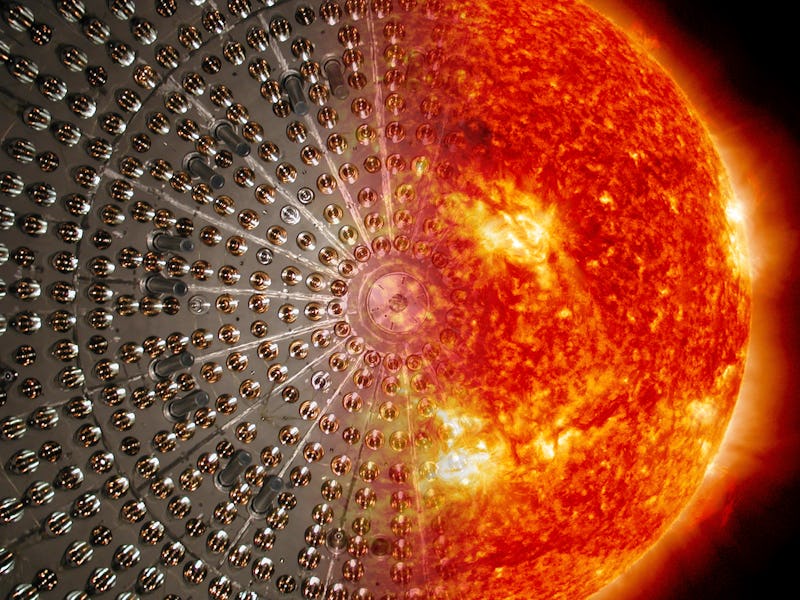Historic neutrino detection could tell us what the Sun is really made of
Scientists are getting to the core of the matter.

Stars are born in the collapse of massive clouds of gas and dust. Over their billions of years of existence, stars are fueled by nuclear fusion, which converts hydrogen into helium.
This is a two-step process. The first is the proton-to-proton chain that only involves hydrogen and helium, accounting for 99 percent of the Sun's energy. The second includes other elements, including carbon, nitrogen and oxygen. Both of these processes produce an elusive, minuscule particle known as a neutrino — the only true indication of what's going on inside stars.
But until now, these particles had never been detected in a star's secondary fusion cycle.
Using a highly sensitive particle detector in Italy, a team of scientists announced Wednesday they have detected neutrinos produced during the Sun's secondary fusion cycle. Their landmark discovery offers unprecedented insight into the elements found in the Sun's core and the structure of our star.
"Now we finally have the first groundbreaking, experimental confirmation of how the stars, heavier [sic] than the Sun, shine," Gianpaolo Bellini, professor at the University of Milan and researcher at INFN, and one of the leading authors behind the latest experiment, said in a statement.
The new finding is detailed in a study published Wednesday in the journal Nature.
Artist's concept of the Borexino detector merged with the Sun.
Particle fever — Neutrinos are a neutral, subatomic particle with a tiny mass that's close to zero — smaller than the mass of any other known particle.
"Fusion reactions in the Sun produce an astonishing number of neutrinos: roughly 100 billion solar neutrinos pass through each of your thumbnails every second," writes Gabriel Orebi Gann, associate professor of physics at University of California, Berkeley, in an accompanying viewpoint also published Wednesday in Nature. Orebi Gann was not involved in this study.
Neutrinos emitted during the first process have been detected by scientists before. But the neutrinos produced by the second process are much harder to detect since their signal is so faint, they are lost in background noise.
To cut through the din, scientists turned to the Borexino particle detector at the Gran Sasso National Laboratories of the Italian National Institute for Nuclear Physics.
Scientists were finally able to detect neutrinos produced by the Sun's fusion cycle using the Borexino particle detector in Italy.
This particle detector is specially made to detect neutrinos and drown out noise. It has an onion-like design with layers and layers of increased radio sensitivity to be able to detect really faint signals that just can't be measured by any other detector. The detector is also in an underground lab, which protects it from cosmic radiation interference.
"The detection of neutrinos produced in the [carbon-nitrogen-oxygen] cycle announced by Borexino is the crowning of a relentless, years-long effort that has led us to push the liquid-scintillator technology beyond any previously reached limit, and to make Borexino's core the least radioactive place in the world," Marco Pallavicini, professor at the University of Genoa and study co-author, said in a statement.
The two nylon vessels in the core of Borexino filled with water during the initial operation of the detector .
This is the first experimental evidence scientists have for the secondary fusion cycle and the elements involved in it, according to the study.
Now that scientists have detected these elusive particles in the secondary fusion cycle, they will be able to measure the abundance of elements such as oxygen, carbon, and nitrogen in the star's core.
"This result is a huge leap forward, offering the chance to resolve the mystery of the elemental composition of the Sun’s core," Oberi Gann writes.
If scientists can precisely measure the elements in the Sun's core, then it enables them to better understand what truly fuels the star and other massive stars like it — and how they form in the first place.
Abstract: For most of their existence, stars are fuelled by the fusion of hydrogen into helium. Fusion proceeds via two processes that are well understood theoretically: the proton– proton (pp) chain and the carbon–nitrogen–oxygen (CNO) cycle1,2 . Neutrinos that are emitted along such fusion processes in the solar core are the only direct probe of the deep interior of the Sun. A complete spectroscopic study of neutrinos from the pp chain, which produces about 99 per cent of the solar energy, has been performed previously3 ; however, there has been no reported experimental evidence of the CNO cycle. Here we report the direct observation, with a high statistical signifcance, of neutrinos produced in the CNO cycle in the Sun. This experimental evidence was obtained using the highly radiopure, large-volume, liquid-scintillator detector of Borexino, an experiment located at the underground Laboratori Nazionali del Gran Sasso in Italy. The main experimental challenge was to identify the excess signal—only a few counts per day above the background per 100 tonnes of target—that is attributed to interactions of the CNO neutrinos. Advances in the thermal stabilization of the detector over the last fve years enabled us to develop a method to constrain the rate of bismuth-210 contaminating the scintillator. In the CNO cycle, the fusion of hydrogen is catalysed by carbon, nitrogen and oxygen, and so its rate—as well as the fux of emitted CNO neutrinos—depends directly on the abundance of these elements in the solar core. This result therefore paves the way towards a direct measurement of the solar metallicity using CNO neutrinos. Our fndings quantify the relative contribution of CNO fusion in the Sun to be of the order of 1 per cent; however, in massive stars, this is the dominant process of energy production. This work provides experimental evidence of the primary mechanism for the stellar conversion of hydrogen into helium in the Universe.